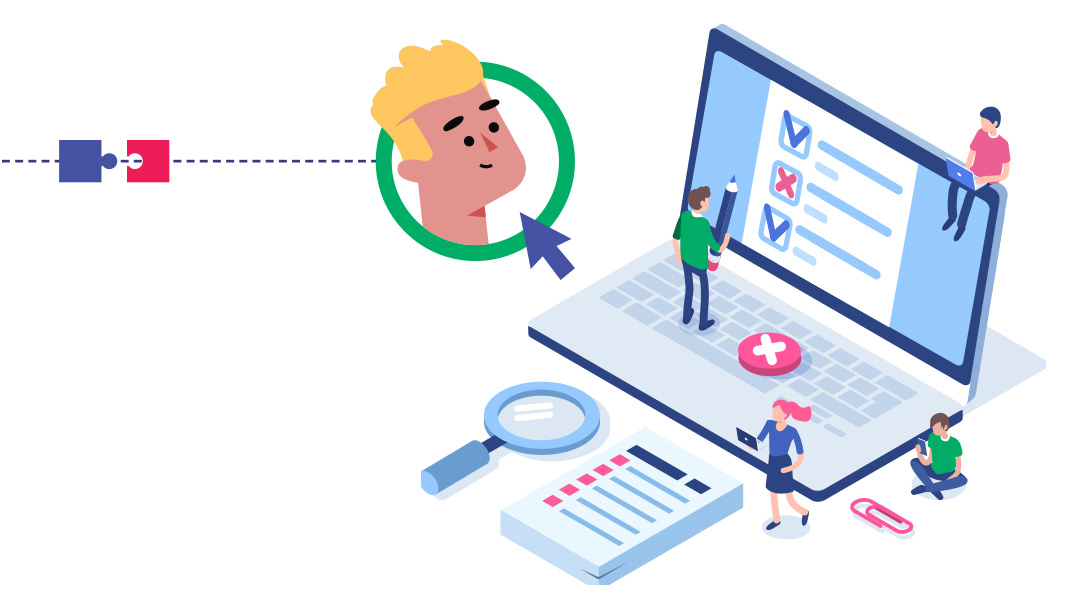No Code or Low Code
| August 8, 2023Which type of automation is the best fit for your needs?

I swung lazily back and forth and looked at Avi, manager of a large not-for-profit organization that guides parents toward a diagnosis for children with learning differences. He’d reached out to consult with me about revamping the organization’s software, and had asked me to come in.
“I’ve never started a meeting off on a swing,” I said to him.
“I wanted you to really get a feel for how we work, and I figured this is the best way to do it,” he said standing next to several stuffed bean bags.
I appreciated that. Taking one last look at the colorful room, I let the swing slow to a stop and followed Avi to his office.
Once settled in his office, I got down to business. “At our last meeting, you described to me what you’d like your software to be able to do. Have you thought about it anymore?”
Avi pointed to his colleague, who had just walked into the room. “Boruch is our director of clinical services. I’d like him to be involved in the final decision.”
“Great!” I looked over at Boruch. “So, just a quick recap: At our last meeting I got a sense of the software you need to fill your needs. It seems pretty clear there’s nothing on the market that works, and we discussed the options going forward for creating software tailored to your exact needs.
“Option A is ‘semi-custom.’ It’s when you use a premade base and add additional functions as needed.
“Option B is ‘no-code.’ It’s software that allows you to drag and drop elements to create software with minimal or no code.
“Option C is ‘fully custom.’ That’s when a software expert uses code to write the software from scratch.”
Boruch looked up. “I’m no software expert, but it seems like a no brainer to me — of course we want no code. But honestly,” he added, after pausing for a few seconds’ thought, “it sounds too good to be true. Can anyone who wants to create software really do it himself?”
Do you need to know code to use no-code?
Recently there’s been a lot of talk in the software world about no-code. This new development makes software creation so much faster and cheaper, and seems to preclude the need for experts. It’s an exciting and tempting concept.
The question is: Is it as easy as it sounds? Can you actually create any type of software, or are there still some advantages to creating software using plain old code?
We need to distinguish between different platforms, all ostensibly no-code. Now that no-code has become a buzzword, every platform has started identifying themselves as such, even though some just have limited no-code functionality.
Let’s break it down:
>Off-the-shelf platforms that have a “no-code option.” Many ready-made platforms started advertising a no-code option. That does not mean that you can create software using it. It means that within the main function of the platform, like project management or a CRM (customer relationship management), you’re able to customize certain elements.
Examples include: SmartSuite, Monday.com
>Purely no-code platforms: These are platforms that are exactly what people mean when they refer to no-code. These platforms have a bar at the side with different elements that users might want to use in their software. Those elements can include a button, text, a link, a chart or table, a database, a navigation bar, etc. There’s also an option to add code when there’s something needed and there’s no premade element doing it.
You don’t need a computer programmer to create software with this kind of platform, but generally you need to be very technologically savvy to navigate it. You also need a deep understanding of the logic behind software.
Example: bubble.io
>“Low-code”: Some no-code platforms are better referred to as “low-code.” They have many of the same pre-made elements as a no-code platform, but some code is needed to make the system work.
Example: Retool
“I hear what you’re saying.” Boruch looked disappointed. “I was hoping to create the software myself, but it sounds like the program we hope to create will need some code. Just no-code isn’t going to cut it.”
I laughed. “Don’t worry, making software yourself is not as much fun as it sounds.”
Boruch still seemed to be thinking, “Why did you even mention fully custom software at all?” He finally spoke up. “If no-code or low-code is an option, why would anyone go fully custom?”
“Good questions!” I told Boruch.
No-Code vs. Fully Custom
In theory, it sounds like you can do anything with no-code. If there’s a pre-made element for what you need, you use it, and if not, you just add code. But while it sounds simple, in reality it isn’t. Although technically most things are possible with no-code, it’s sometimes easier to create the software from scratch.
“What?” Boruch looked horrified. “That makes no sense at all!”
“You’d be surprised.” I smiled.
While someone not acquainted with programming might assume that the less code used, the better, developers know that when they set up more complex software, they often find themselves needing to work around the preexisting settings of the no-code platform.
In other words, the no-code platform has a certain method for getting things done (i.e., how it authenticates users), but the company may need something more complex.
If the platform’s methods don’t work for your needs, then the workaround can be more complicated than writing the software yourself in the first place.
“How do we know if we’re in that category?” Avi jumped in, getting practical.
“Whether you’re going no-code or fully custom is a choice the person setting up your software — in this case, me — needs to make. It isn’t something you would know on your own.
“But there’s another major factor in this decision, aside from the settings, that I need you to be involved in.”
I stood up too quickly at the end of the meeting and was dizzy for a second, the way I’d felt when I got off the swing before. Small price to pay for the joy of helping them reach clarity on their needs instead of swinging back and forth with their options.
The platform’s look and feel (UI/UX)
No-code uses pre-made blocks, resulting in a certain “look.” There’s no way to work around that. The design of your platform needs to fit in with the general template that no-code offers. If you need your platform to have a particular UI/UX feel, then it might be worth going fully custom.
Once set up correctly with proper controls, you’ll see just how much of your work automations can do risk-free!
Liora Waxman is the Director of Content Strategy at TidyStack, a company that creates and sets up software/automations for businesses to perfectly fit their needs.
(Originally featured in Mishpacha, Issue 973)
Oops! We could not locate your form.







